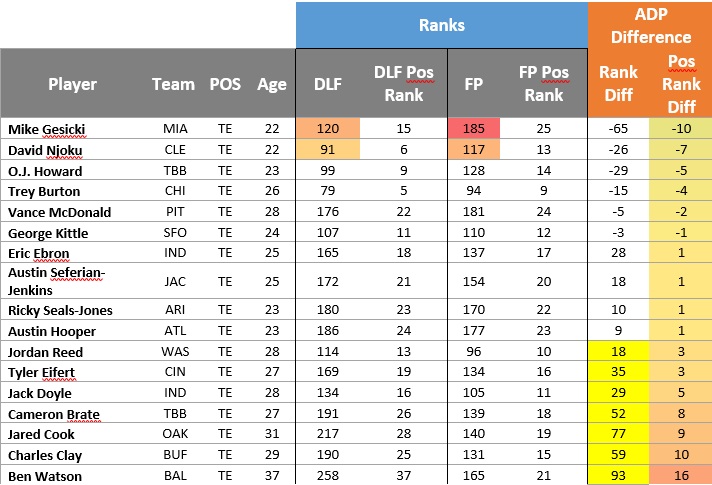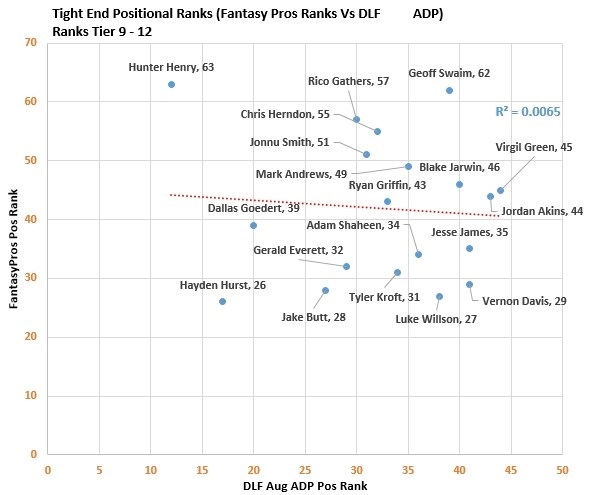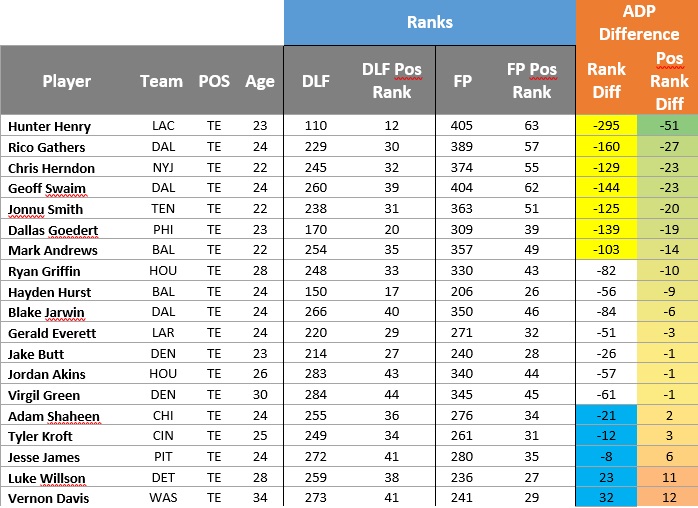The Difference Between Dynasty and Seasonal Ranks, Part Two: Tight Ends
The mob is dead, all hail the mob! While we are always learning more about how we value players individually in dynasty, there is still a great deal we can learn from a mass consensus. Seasonal FantasyPros ranks are one such mass consensus. I’ll continue our four-part series looking at the difference between DLF’s August ADP and FantasyPros 2018 ranks with tight ends.
I’m going to break the position down by rankings between DLF’s August ADP and FantasyPros seasonal rankings. I’ll examine each player currently being drafted in dynasty by sorting through tier groupings as well.
Our goal is to learn more about how we value players in the long and short term. While also hunting and highlighting short-term buys and long-term values.
Depending on the make-up of your team and style of player, your “buy” and “sell” may be a polar opposite of someone else’s. So for this series – but so we all know what’s going on – I have set a standard definition for both of these terms.
Short-term sell = All players who are ranked higher in dynasty than in FantasyPros rankings.
Short-term buy = Any player ranked high in FantasyPros rankings but lower in dynasty.
You can no doubt figure the rest out from there.
Be sure to check out part one in this series where I broke down the running back position.
[am4show have=’g1;’ guest_error=’sub_message’ user_error=’sub_message’ ]
Overall Ranks

There is a lot less correlation between seasonal and dynasty values at the tight end position, compared to running back. We disagree more on who is a value when considering just next season compared to multiple seasons in the future. Given the tendency for new tight ends to take a year or two before picking up fantasy value, this makes perfect sense.
Hello Hunter Henry! Currently unranked in Fantasy Pros seasonal rankings – because he’s not going to play in 2018 – I assigned him the very last rank and positional rank. That makes him stick out like a sore thumb even from this level of elevation.
We still like Henry in dynasty, however he has dropped to the TE12 from TE4 this time last year. Since we expect him to come back healthy next year, this may well be a buying opportunity for anyone taking a long-term view.
Now let’s dig a little deeper and see if we can’t really see what’s going on in here.
Tier Grouping One (Tiers 3-5)
Understandably, no tight end is in the first two tiers for Fantasy Pros 2018 rankings. However, they are drafted quicker in dynasty leagues as a rule. All top-ten dynasty tight ends are off the board in seasonal rankings by rank 128, over 20 spots after the last one disappears in dynasty ADP. This is partly because a number of other, short-term tight ends, are drafted in between. But even taking that into account, dynasty likes tight ends more.
According to DLF ADP, dynasty leagues snatch up tight ends at a faster rate than seasonal rankings with one tight end being drafted for every five picks (1/5) compared to one in every nine in seasonal ranks (1/9).

The top-tiered tight ends have only the second highest correlation in the tier groupings. In other words, we disagree quite a bit on who should be drafted when at the position. This is where some of the disconnect we see in the overall rankings comes from. I have included the FantasyPros ranks with the names for each point on the graph to make it easier to see where this difference is coming from.
Short-Term Buy: Greg Olsen and kinda/sorta Jimmy Graham, Delanie Walker
Short-Term Sell: None
Only one player being drafted inside the top ten in seasonal ranks is being drafted outside the top ten in dynasty: Greg Olsen. There is a single spot difference between for Jimmy Graham and Delanie Walker, but neither looks like a great value. In this way, the top tiered players are difficult to trade for within the position (“tight end for tight end”). However, this makes me wonder how they look compared to other positions in both formats. We’ve already seen there is a significant difference in the rate we draft tight ends. Does that change at all inside the tiers?

Yes. Again this reflects another significant difference in the rate at which we draft tight ends in different formats. While in dynasty we draft tight ends faster overall, we are actually more willing to take the “best of the rest” at the position later than seasonal leagues.
The “Kyle Rudolph Rule”: A productive tight end, who is not considered (i.e drafted) as a clear-cut difference maker at the position, is always a sell for anyone “thinking long term.” They have more value for players with immediate goals.
This is why there are four players being drafted in and around pick 100 in a dynasty who do not make it out the top 80 in seasonal ranks. Tight ends with more immediate value are often targeted earlier in seasonal leagues. Therefore they can be short-term buys in dynasty as well.
Out of process Long and Short Term Buy: Evan “The Weirdo Value” Engram
There is no perspective which does not make Evan Engram a buy. He is valued as a fifth overall tight end in seasonal leagues, and the fourth in Dynasty. And yet he is drafted significantly after the top three players. This means we think he has immediate, short-term value, but he comes at a discount from the players ahead of him.
He is both a long and a short-term buy, though, right? Because he’s incredibly young and ranked in the top five in seasonal ranks.
It seems we are wary of his second year with the return of Odell Beckham and arrival of Saquon Barley in both formats. But not enough to move him out the top five.
Or maybe we just need more than one year to start drafting a tight end in the top 40
…unless you’re Zach Ertz
….I guess. (*Pssst* Ertz may be a sell)
Tier Grouping Two (Tiers 6-8)
Otherwise known as the “what the hell, anyone can score a touchdown!” group. Alternatively, in dynasty, it’s the “You don’t know what you’re talking about, this player is bound for the top 12 and will definitely go up in value.”
In the end, I think “Tier Grouping Two” is pithier.
Perhaps unexpectedly, we agree on this group more than any other. We know who the potentials are, and we agree they are also decent streamers this year.

Short-Term Buy: Jordan Reed and Jack Doyle
Short-Term Sell: Mike Gesicki
Mike Gesicki stands out from the group as the clear dynasty favorite who isn’t being considered, wisely, as a top-20 tight end this season. Where I’m using FantasyPros ranks and not seasonal ADP, you may find the person in your league with Gesicki is irrationally high on him this year… because the number one rookie tight end owner is normally irrational high in drafting/trading for rookie tight ends. That’s my guess anyway… they’ll probably mention how athletic he is… I mean Rob Gronkowski and Jimmy Graham didn’t break into the top five until year two and they’re only two of the best players to ever take on the position in NFL history, so…. slackers.
Positionally, the short term buys might not look like such a great value, but they are the meat in this tier group. Again the truth is in the other ADP.

The values I’ve highlighted in yellow are decent short-term buys. I just listed the two ranked highest in FantasyPros seasonal ranks above.
In truth, I think Charles Clay is ranked way too low in both and I want him on the short-term buy list as well. He makes an interesting value proposition because he’s ranked so much lower than in both formats.
Dark Horse Short Term Flyer: Eric Ebron
It sticks out that even though Ebron is ranked with a single point difference in positional value, he is held 28 spots higher in seasonal ranks. This has an Engram feel to it, though obviously a very different floor and ceiling. He is fairly young at 25 years old, and there is a slight inkling in seasonal rankings that he could return value in 2018 (compared to his dynasty ADP anyway).
Tier Grouping Three (Tiers 9-12)
Anarchy! We agree on nothing in the third tier grouping. Even when you take Hunter Henry out of this group again, the R^2 value still stays below 0.0.

Short-Term Buys: Adam Shaheen and Luke Willson
Short-Term Sells: Hunter Henry and Rico Gathers
This four stick out as the biggest valuation difference on either end of the scale. Personally, I’ve been leaning towards Shaheen anyway because Trey Burton has scared off so many from a prospect we considered every promising last year. That’s my process: be interested in the guy everyone liked last year, but now don’t want.
But in this wild, wild, west of disagreement, I suspect this is a “find your guy” shoot out. If you’re trading for these players I imagine he won’t be going below sticker price. However, if you have one of these players on your team, I suggest following the trend here and cash out or in.
Short-term thinking doesn’t value tight ends outside the top 12 the same way. They just don’t have the same value outside the top-12 players as they do in dynasty. While we know the top three tiers are drafted faster in ADP, we also know the position as a whole is drafted quicker in dynasty with that 1/5 ratio – players to picks – we saw earlier.
Another way of seeing this is that all 44 players listed here are drafted by pick 284 in DLF ADP, but the last rank in FantasyPros is 404 (and they’re not even drafting Hunter Henry).
Dynasty players are willing to take “potential” at the position earlier by and more often outside the top eight players.
I think that means these values should also be exaggerated up or down for anyone thinking short term.

I’ve highlighted the most devalued players in seasonal leagues (long-term buys) in yellow, the short term sells are highlighted in blue.
In conclusion
Dynasty players love to hunt for value. In seasonal leagues, where roster space is less common, the opportunity cost is greater, and streaming is rampant, it would almost no sense to value them the same way.
Once again, I think I learned a lot more about the position having compared to two. The values for the long and the short term are interesting and actionable. But the more I look into this, the more I feel that the real edge is getting closer to understanding how fantasy players play.
There is definitely an edge to be had in trades, and drafts, by understanding the effect the long or short-term view has on fellow owners when they look at different positions.
[/am4show]
- Peter Howard: Dynasty Fantasy Football Superflex Rankings Explained - March 6, 2024
- Dynasty Target and Regression Trends: Week 15 - December 23, 2023
- Dynasty Target and Regression Trends: Week 14 - December 16, 2023


































































